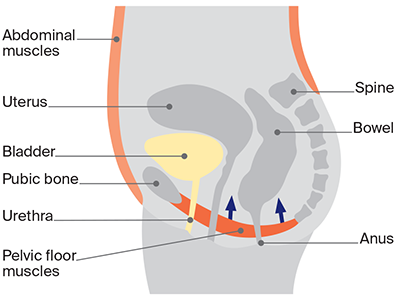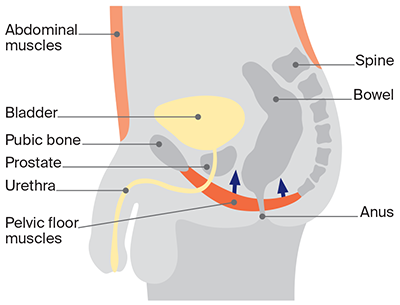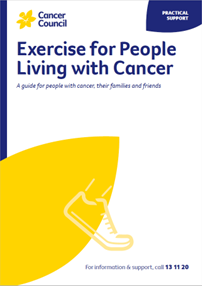- Home
- Cancer Information
- Managing side effects
- Sexuality, intimacy and cancer
- Overcoming specific challenges
- Incontinence
Incontinence
Trouble controlling the flow of urine (urinary incontinence) or flow of faeces (faecal incontinence) is a common side effect of treatment for cancer of the prostate, bladder, bowel and penis, or of the female reproductive organs. Incontinence may be temporary or permanent. The pelvic floor muscles that affect bladder and bowel control also affect sexual function and arousal. Having bladder or bowel issues can be embarrassing and impact your sexuality, but there are ways to manage symptoms. For advice on incontinence, call the National Continence Helpline on 1800 33 00 66.
Learn more about:
Tips for managing bladder and bowel issues
- Let your partner know that incontinence may occur.
- Cover your bed with large, fluffy towels or have sex in a wet area like the shower.
- If you have a catheter for draining urine, tape the tube to your skin, remove the bag and insert a flow valve or stopper before sex. For a catheter from a penis, fold the catheter back against the penis and put a condom on top to hold it in place.
- If you’ve had your prostate removed, try having sex in the missionary position with you on the bottom and your partner on top.
- Talk to a continence nurse about plugs for rectal use if you have faecal leakage.
- Learn how to exercise your pelvic floor muscles. See the images and video below for instructions.
- Wait at least 2–3 hours after a meal, and empty both the bowel and bladder before having sex.
- Try positions that reduce pressure on the bladder such as being “on top”.
- See a pelvic health physiotherapist for advice. Ask your GP for a referral..
How to exercise your pelvic floor muscles
To identify your pelvic floor muscles, try stopping your urine stream for a couple of seconds while emptying your bladder. You use your pelvic floor muscles to do this. Pelvic floor exercises should be done several times a day. The technique is the same for males and females.
Female

Male

Video: How to exercise your pelvic floor muscles
The technique is the same for men and women (see the images above and watch video below).
- Start by relaxing all of your pelvic floor and tummy (abdominal) muscles.
- Gently lift your pelvic floor muscles up and hold while you continue breathing normally. Keep your upper abdominal muscles relaxed. Try to hold the contraction for up to 10 seconds. Relax your muscles slowly after each hold.
- Repeat the exercise up to 10 times, with a rest of 10–20 seconds between contractions. Relax your pelvic floor muscles completely during the rest periods.
→ READ MORE: Changes in appearance
More resources
Dr Margaret McGrath, Head of Discipline: Occupational Therapy, Sydney School of Health Sciences, The University of Sydney, NSW; Yvette Adams, Consumer; Dr Kimberley Allison, Out with Cancer study, Western Sydney University, NSW; Andreea Ardeleanu, Mental Health Accredited Social Worker, Cancer Counselling Service, Canberra Health Service, ACT; Kate Barber, 13 11 20 Consultant, Cancer Council Victoria; Dr Kerrie Clover, Senior Clinical Psychologist, Psycho-Oncology Service, Calvary Mater Newcastle, NSW; Maree Grier, Senior Clinical Psychologist, Royal Brisbane and Women’s Hospital, QLD; Mark Jenkin, Consumer; Bronwyn Jennings, Gynaecology Oncology Clinical Nurse Consultant, Mater Health, QLD; Dr Rosalie Power, Out with Cancer study, Western Sydney University, NSW; Dr Margaret Redelman OAM, Medical Practitioner and Clinical Psychosexual Therapist, Sydney, NSW; Kerry Santoro, Prostate Cancer Specialist Nurse Consultant, Southern Adelaide Local Health Network, SA; Simone Sheridan, Sexual Health Nurse Consultant, Sexual Health Services – Austin Health, Royal Talbot Rehabilitation Centre, VIC; Prof Jane Ussher, Chair, Women’s Heath Psychology and Chief Investigator, Out with Cancer study, Western Sydney University, NSW; Paula Watt, Clinical Psychologist, WOMEN Centre, WA.
View the Cancer Council NSW editorial policy.
View all publications or call 13 11 20 for free printed copies.
Need to talk?
Support services
Coping with cancer?
Speak to a health professional or to someone who has been there, or find a support group or forum
Life after cancer treatment
Webinars, exercise and nutrition, sexuality programs, and back-to-work support
Cancer information
Your coping toolbox
Strategies for managing difficult situations during and after cancer treatment
View our publications
Guides and fact sheets for people with cancer, their families and friends

